By Jeffrey A. Rendall, Photos By Jeffrey A. Rendall
You won't find much of Montana in Southern California. Anyone who's spent an appreciable amount of time in the Big Sky state knows the landscape is as devoid of humans as anywhere you'll encounter in the United States. There are probably plots of ground in the state where you'll not have a single bipedal animal anywhere within 10 square miles (Sasquatch not included here).
Southern California, on the other hand, is hardly known for its population-free wide-open spaces. Most everywhere you go from Ventura on down to San Diego will have its share of human inspired architecture, often bunched together in densely populated streets and neighborhoods. There's plenty of land here -- it's just got a lot of people on it.
So something must give when you think about finding the Big Sky in Southern California. That's why it's strange when you hear folks talking about the Lost Canyons golf facility in Simi Valley -- with people comparing it to Wyoming and Montana -- not exactly a true fit for the LA Basin.
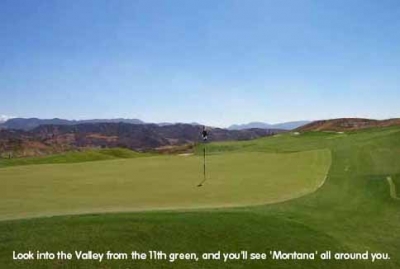 |
Rick Adams, Lost Canyons' Tournament Director and unofficial on-course historian, says Pete Dye and Fred Couples liked the property quite a lot -- in large part because it reminded them of somewhere else: "Dye and Couples were just amazed at the suitability of this property for a couple outstanding golf courses. We decided to call the first one the Sky Course because when you're out there, there's an incredible contrast between the canyon tops and the sky itself. As Fred described it, the land feels like you're in Montana or Idaho, where the hillsides frame the sky."
That's no exaggeration. The Sky Course offers an up and down journey through Tapo Canyon, with very little civilization in sight. You'll discover incredible canyon views, and one of the most spectacular skies anywhere on a clear day. If the temperature were about 40 degrees cooler and there were some pine trees, you'd be in Montana. But here in Southern California, you're more likely to come across coyotes rather than Grizzly Bears.
In addition to the 'somewhere else' ambiance, the property played host to the production sets for several notable entertainment shows, Little House on the Prairie and Bonanza carrying the most significant titles. Our forecaddie, Mark Kiernan, pointed to a group of oak trees that figured prominently in the opening and closing sequences of the aforementioned mid-seventies TV show. I almost expected Melissa Gilbert to come skipping down the slope at any moment with the ghost of Michael Landon giving chase -- but I guess she's too busy acting as President of the Screen Actor's Guild these days.
Golf now replaces Walnut Grove and the Ponderosa Ranch in the Lost Canyons. But the secluded feeling still remains.
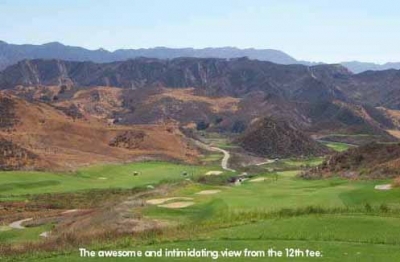 |
The setting does not overshadow the golf course, however. It's not a stretch to pronounce that Lost Canyons was something the Los Angeles area desperately needed -- a world-class golf facility, open to the public. Having grown up in Southern California, I'm fully aware of the quality golf courses you'll find there -- but must be a member to play.
Adams puts it succinctly: "The way the golf course is set-up and conditioned, it's like a four-star resort that you'd find in Palm Springs or Monterrey, but it's right here immediately accessible to Los Angeles." In a sense, it puts LA public golf on the map.
The Sky Course and its sister, The Shadow Course, are two PGA tournament caliber golf courses. They're severe tests (149 Slope for both) from the back tees, and would make for spectacular television coverage if given the opportunity.
And as is typical for Pete Dye, he placed the layouts in the striking natural environment with as little disturbance as possible. For this reason, both courses sport a significant amount of native vegetation, resulting in a number of forced carries and target oriented shot values.
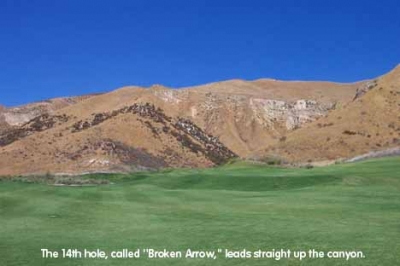 |
Both courses deserve special description -- here we'll concentrate on the Sky Course.
As given away by the name, the Sky Course emphasizes upward glances to the heavens. Though I'd say both courses play similarly, they do have some different characteristics. The Sky Course's fairways and greens are much larger than the Shadow Course's, but it also plays 245 yards longer.
Rick Adams says you'll play Links-style golf on the Sky, and this is where Couples made his biggest contribution. "Couples really helped out by lending his experience with British Open style Links courses you'd find in the birthplace of golf. For this reason, Fred and Pete Dye worked more on the yardage of holes, rather than their shapes and characteristics."
Adams continues, "That's why many of the par fours on both golf courses are either right at 300 yards or seem about that distance -- with the idea they'd play like some of the great short par fours in Scotland and Ireland, where distance isn't as much of a factor. You'll have the opportunity to drive the putting surfaces, but the closer you get to the greens, the more severe the trouble becomes. They're high-risk, high-reward--but at the same time, for the double-digit handicapper, it gives them the choice of using a three-wood and a pitching wedge into a green on a lot of holes."
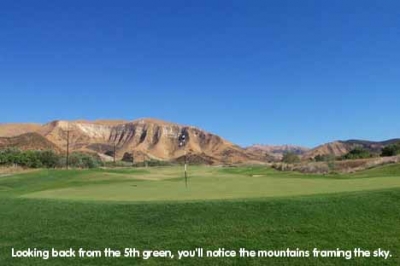 |
Because the Sky plays like a Links course, it's often best to try and play short of the flag. The course features very slick A4 bentgrass greens, and there's a fair amount of trouble for those who go long -- it's clear that Dye's generous run-up areas on most holes suggests the shot he'd like you to play.
And it's hardly ever wise to mess with Dye's thinking -- you'll lose more often than not. As Adams correctly points out, Dye favors players who command a high fade as opposed to a low draw: "The player that hits a low draw is penalized on a lot of Dye's golf courses, and it's certainly true here. The most severe trouble around the greens tends to be back and left on most of the greens."
In other words, it's a good idea to think before you thump. Don't get lost in the skyward views, play the correct set of tees, sit back and enjoy the view.
The Sky Course starts with one of those short par fours Adams describes above, 325 yards and severely uphill. Bunkers on the left, 220 yards from the tee will catch anything with too much draw. Bunkers on the right are 275 yards from the tee, which leads me to believe they're there to frame the landing area rather than play for anyone but Fred Couples and Tiger.
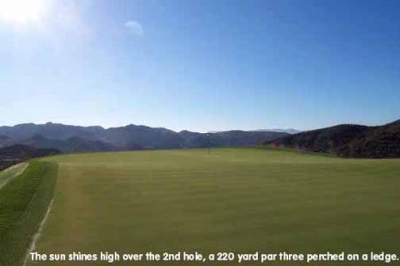 |
Two is unquestionably one of the most spectacular par threes anywhere. You'll shoot over a lot of trouble to a green that appears like it's perched on a ledge, with the valley as a backdrop down below. Stunning. Lose a ball? Who cares -- enjoy the view.
Four's an interesting par five. 580 yards and uphill, you'll weave your shots in and out of a canyon in what amounts to a double dogleg. Generous landing areas for all shots make it play tamer than it sounds.
Five, six and seven are the flattest holes on the course, lying at the base of the canyons. A nice stretch of holes -- par five, four and three, respectively -- all distinct, all challenging.
Nine's the Sky course's #1 handicap hole, a 485 yard monster dogleg right. If you've got length, the hole plays much easier because most of the challenge lies in carrying the course's only lake. The more you fade, the more water you'll need to carry -- but the shot's downhill, if that makes it any more reassuring!
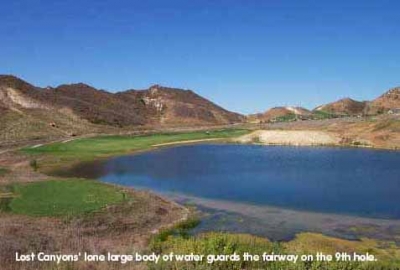 |
Moving to the backside, thirteen, fourteen and fifteen represent the strongest stretch of holes on the inward nine. Another three, five, four par sequence, you'll start with the 230 yard thirteenth, which Adams says reminds him of a desert scrub version of Augusta National's twelfth. Sure enough, the hole plays downhill to a green that seems to go away from you, bunkers on the right side and a slope to the left.
Fourteen's got the most interesting tee shot on the course -- you're essentially shooting over a hill to a partially hidden, but very wide fairway (shades of Ireland on this tee view). The second shot presents many choices on what club to hit. Once again, the more you risk, the greater the potential reward. Further, pay close attention to the pin placement, as this green is 46 paces deep--with a tricky slope adding to the difficulty.
Fifteen's name is 'Barranca,' which suits it well, because it appears from the tee like you'll be playing out of it if you're slightly off. Not true -- once again, the fairway's wide, but this hole's green is the smallest on the course and you'll face another carry over 'barranca' to reach the putting surface.
Seventeen's another incredible par three -- this time relatively short at 170 yards. A huge bunker waits short and a pot bunker long if the pin's back left on this huge (53 paces) green. Another beautiful view!
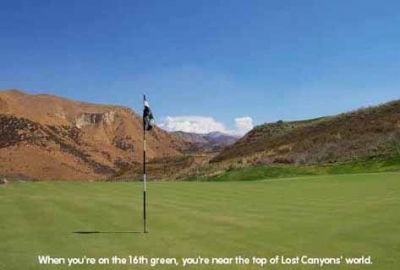 |
Eighteen plays much shorter than its 460 yards would indicate, mostly because you'll get a significant amount of roll on the downhill tee shot. Chock up a three hundred yard drive, then add a short iron approach and you'll tell your friends you hit a driver-nine iron on a 460 yard hole.
That's a pretty fitting close to the Sky Course. Yardage isn't always indicative of what's out there -- and Dye wants you to 'think' your way around. If your cranium's larger than your titanium driver's head, you'll score much better on this course. So take a trip to Big Sky country in Southern California and discover what Pete and Fred have in store for you -- you won't regret it.
Details:
The Sky Course at Lost Canyons
3301 Lost
Phone: (805) 522-4653
FAX: (805) 522-1389
Website: www.lostcanyons.com
Head Golf Professional: Rick Adams, PGA (note: Rick Adams is now the Head Golf Professional at Lost Canyons)
Course Architects: Pete Dye, with Fred Couples consulting
|
|
Yardage/Slope |
|
Black |
7250/149 |
|
Gold |
6770/143 |
|
Silver |
6205/133 |
|
White |
5605/124 |
|
Copper |
4885/120 |
Rates:
Mon-Thurs, $95. The forecaddie is now optional -- $15 per player, plus gratuity.
Fri-Sun, $120. Again, forecaddies are an additional $15 plus gratuity.
Reservations taken up to 30 days in advance. Three day advance reservations required for forecaddie.
| Related Links | Comments on this article? | |
|
Maryland National Golf Club Hollow Creek Golf Club Rocky Gap Resort PB Dye Golf Club in Ijamsville Whiskey Creek Golf Club |
E-mail Jeff Rendall, Editor: jrendall@golftheunitedstates.com |











